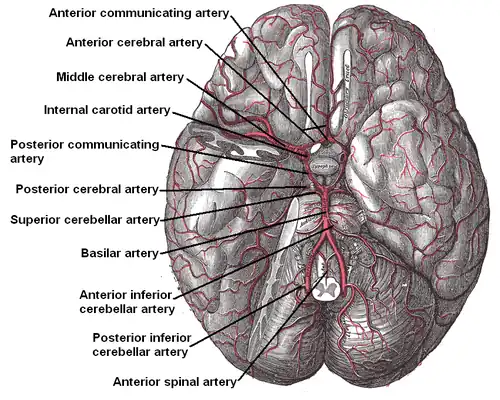| Anterior communicating artery | |
|---|---|
 The cerebral arterial circle and arteries of the brain (inferior view). The anterior communicating arteries (top of figure) connect the left and right anterior cerebral arteries. | |
| Details | |
| Identifiers | |
| Latin | Arteria communicans anterior |
| TA98 | A12.2.07.029 |
| TA2 | 4517 |
| FMA | 50169 |
| Anatomical terminology | |
In human anatomy, the anterior communicating artery is a blood vessel of the brain that connects the left and right anterior cerebral arteries.
Anatomy
The anterior communicating artery connects the two anterior cerebral arteries across the commencement of the longitudinal fissure. Sometimes this vessel is wanting, the two arteries joining to form a single trunk, which afterward divides; or it may be wholly, or partially, divided into two. Its length averages about 4 mm, but varies greatly. It gives off some of the anteromedial ganglionic vessels, but these are principally derived from the anterior cerebral artery.
It is part of the cerebral arterial circle, also known as the circle of Willis.[1]
Physiology
Anatomical variations of the anterior communicating artery are relatively common. The artery is sometimes duplicated, multiplicated, fenestrated ("net-like") or very short, giving the impression that two anterior cerebral arteries are fused at the point where the anterior communicating artery is usually expected to arise.[2]
Normally, the anterior communicating artery does not significantly contribute to cerebral blood supply, as there is negligible net blood flow within it, and some of its anteromedial branches seem to be specially adapted to ease forebrain sodium sensing, rather than to supply the brain with blood.[3]
Pathology
Aneurysms of the anterior communicating artery are the most common circle of Willis aneurysm[4] and can cause visual field defects such as bitemporal heteronymous hemianopsia (due to compression of the optic chiasm),[5] psychopathology and frontal lobe pathology.[6]
In case of narrowing of other arteries of the circle of Willis or the arteries supplying the circle, the anterior communicating artery can provide a way to supply blood to the opposite (affected) side of the circle. This can often preserve the cerebral blood supply well enough to avoid the symptoms of ischemia.[7]

References
![]() This article incorporates text in the public domain from page 572 of the 20th edition of Gray's Anatomy (1918)
This article incorporates text in the public domain from page 572 of the 20th edition of Gray's Anatomy (1918)
- ↑ Neuroscience. Purves, Dale., Augustine, George J., (George James) 1955-, Fitzpatrick, David, 1952-, Hall, William C. (William Charles), 1940-, LaMantia, Anthony-Samuel,, McNamara, James O. (James O'Connell), 1969- (4th ed.). Sunderland, Mass.: Sinauer. 2008. ISBN 978-0-87893-697-7. OCLC 144771764.
{{cite book}}: CS1 maint: others (link) - ↑ Kardile, Poorwa Baburao; Ughade, Jaideo Manohar; Pandit, Sudhir Vishnupant; Ughade, Manohar Namdeo (December 2013). "Anatomical variations of anterior communicating artery". Journal of Clinical and Diagnostic Research. 7 (12): 2661–2664. doi:10.7860/JCDR/2013/6664.3725. ISSN 2249-782X. PMC 3919289. PMID 24551604.
- ↑ Fenrich, Matija; Habjanovic, Karlo; Kajan, Josip; Heffer, Marija (2020-11-16). "The circle of Willis revisited: Forebrain dehydration sensing facilitated by the anterior communicating artery: How hemodynamic properties facilitate more efficient dehydration sensing in amniotes". BioEssays. 43 (2): 2000115. doi:10.1002/bies.202000115. ISSN 0265-9247. PMID 33191609.
- ↑ Beck J, Rohde S, Berkefeld J, Seifert V, Raabe A. Size and location of ruptured and unruptured intracranial aneurysms measured by 3-dimensional rotational angiography. Surg Neurol. 2006 Jan;65(1):18-25; discussion 25-7. PMID 16378842.
- ↑ Aoki N. Partially thrombosed aneurysm presenting as the sudden onset of bitemporal hemianopsia. Neurosurgery. 1988 Mar;22(3):564-6. PMID 3362325.
- ↑ Johnson MK, O'Connor M, Cantor J. Confabulation, memory deficits, and frontal dysfunction. Brain Cogn. 1997 Jul;34(2):189-206. PMID 9220085.
- ↑ de Boorder, Michiel J.; van der Grond, Jeroen; van Dongen, Alice J.; Klijn, Catharina J. M.; Jaap Kappelle, L.; Van Rijk, Peter P.; Hendrikse, Jeroen (October 2006). "Spect measurements of regional cerebral perfusion and carbondioxide reactivity: correlation with cerebral collaterals in internal carotid artery occlusive disease". Journal of Neurology. 253 (10): 1285–1291. doi:10.1007/s00415-006-0192-1. ISSN 0340-5354. PMID 17063318. S2CID 22591168.
External links
- MedEd at Loyola Neuro/neurovasc/navigation/aca.htm
- Anatomy photo:28:09-0221 at the SUNY Downstate Medical Center
- "Anatomy diagram: 13048.000-1". Roche Lexicon - illustrated navigator. Elsevier. Archived from the original on 2014-11-07.
- "Anatomy diagram: 13048.000-3". Roche Lexicon - illustrated navigator. Elsevier. Archived from the original on 2012-07-22.